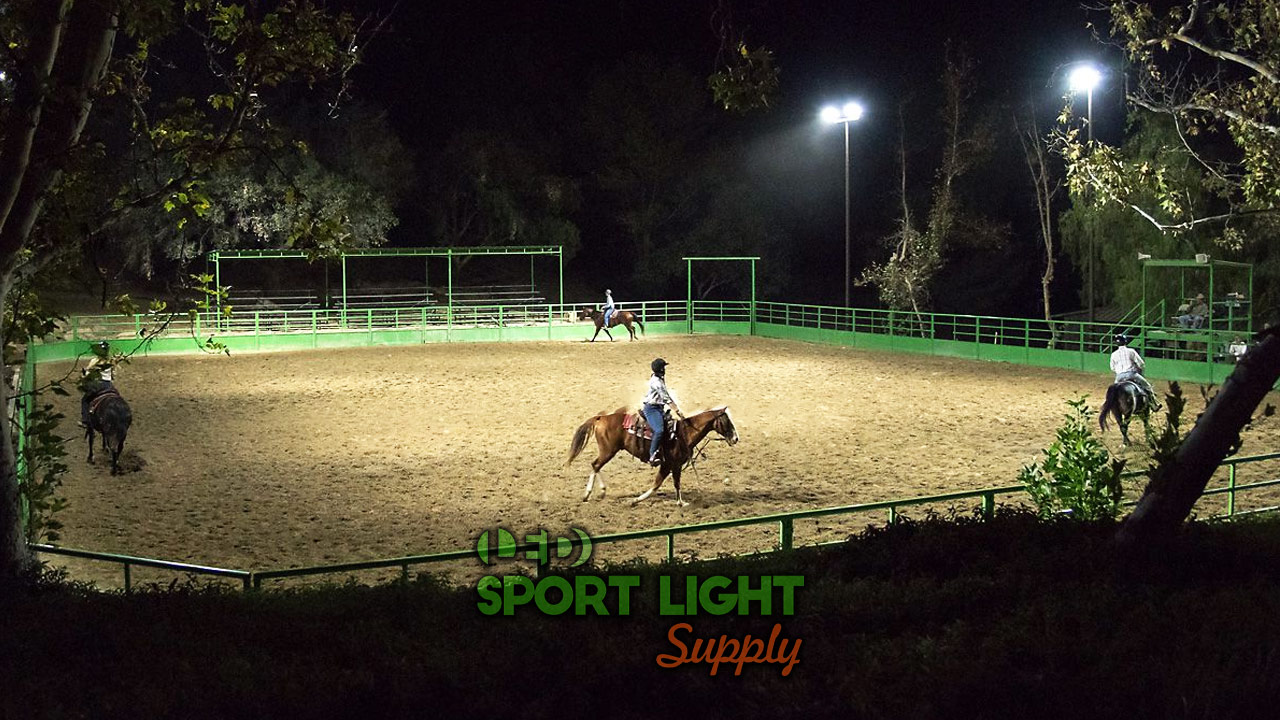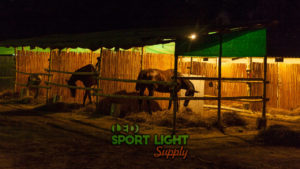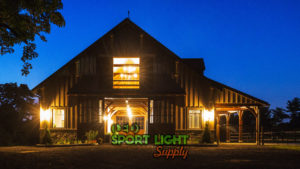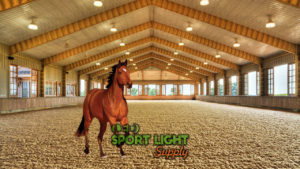What are lux, lumen and watts of horse arena lighting?
1. Lux
This is the brightness required on the riding area grounds. When the Lux level is higher, the brighter the lights will appear. This light value can be measured using a light meter or from a downloaded smartphone app. In the app version, the front and back cameras act as light sensors to measure the Lux levels. In total there are two types of Lux light readings that are taken from the horse arena.
The first is from horizontal light readings. These are measured by putting the light meter approximately one meter from the ground. The direction is taken twice that includes a north and south reading and then a reading from east to west. The horse arena also needs to sectioned-off into square meter sections. Each of these sections needs to have the Lux levels recorded from each direction collected.
When the entire equine arena is cataloged these light readings give a clear report of how well the light uniformity is. This further gives an owner a better idea of how much Lux illuminates the arena. It also allows professional equestrian arenas to improve their current lighting levels to achieve higher Lux.
a) Training
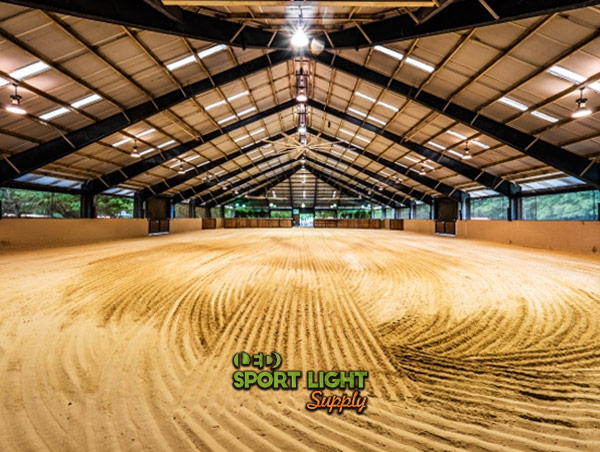 For training purposes, the levels of Lux levels for an indoor structure will differ for different activities. For Dressage training, this measures 200 Lux but will increase to 400 Lux for Show Jumping. As compared to the outdoor arena this allows 100 Lux for Dressage and 150 for Show Jumping.
For training purposes, the levels of Lux levels for an indoor structure will differ for different activities. For Dressage training, this measures 200 Lux but will increase to 400 Lux for Show Jumping. As compared to the outdoor arena this allows 100 Lux for Dressage and 150 for Show Jumping.
b) Intermediate competition
The levels of Lux are going to be increased for the intermediate arenas lighting requirements. This includes 300 Lux for indoor Dressage and 550 Lux for Show Jumping. As for the outdoor level, this allows 200 Lux for Dressage and 300 for Show Jumping.
c) Top level competitions
Professional competitions mean that light levels must be at their finest. For indoor Dressage, it will be standard to have 500 Lux and 700 Lux for Show Jumping. On the light levels outside these will measure 500 Lux for Dressage and Show Jumping.
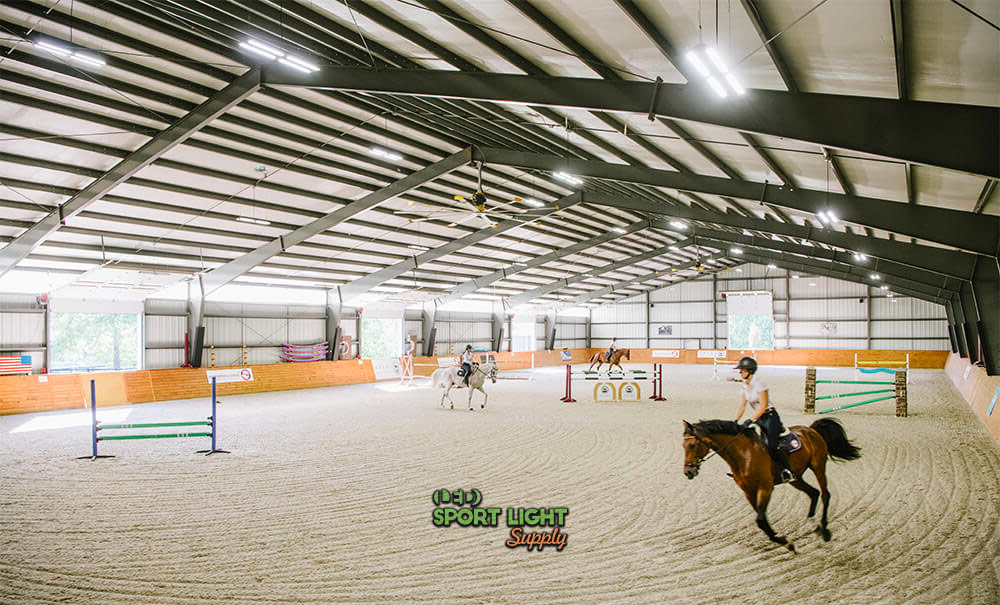
2. Lumen
The output power of the floodlights is going to vary at different levels of every kind of horse arena. These levels of the lumen are measured as Lux levels since Lux and Lumen are so directly related to each other. Here is how they measure-up for each individual level.
3. Wattage
This equals the number of Lumens required. This translates into better energy-efficiency of horse arena lights. For example, if you need 150,000 Lumens for an indoor horse arena, you need to determine the watts used. This narrows down to 150 Lumens per Watt which equals 1000 Watts. The formula is essentially 150,000 divided by 150 and equals 1000. But this energy efficiency depends on the light source.
Therefore, LED offers the highest energy efficiency that ranges from 130 to 150 Lumens per Watt. In comparison, we can also show that metal halide has 75 Lumens per Watt. As for halogen light, this only provides 10-20 Lumens per Watt. The other downside to metal halide and halogen is the amount of wattage used is very expensive. Using higher wattage to get higher Lumen output is equally expensive.
This is why many equine arena owners are switching to a cheaper and cost-effective solution. LED lights are more effective and allow the right amount of Lumens with a much lower Wattage that is used. In terms of cost savings, this is better since it continues for many years after that.
How many Lux to light a riding arena?
These levels all have differences for the indoor and outdoor horse arenas. Here is what the averages are stating for practice levels up through the professional competitions. These measurements aren’t always lower for outdoor events and can be raised at the discretion of equestrian arena owners.
| Level of competition | Lux required to light a riding arena |
| Training | 200 to 400 lux |
| Dressage / Intermediate competition | 300 to 550 lux |
| Professional show jumping | 500 to 700 lux |
1. Training
Dressage training for indoors will measure 200 Lux and 400 Lux for Show Jumping. As for outdoors, this is 100 Lux for Dressage and 150 for Show Jumping.
2. Intermediate competition
This is 300 Lux for indoor Dressage and 550 Lux for Show Jumping. The outdoor level is 200 Lux for Dressage and 300 for Show Jumping.
3. Top level competitions
Indoor Dressage has 500 Lux and 700 Lux for Show Jumping. Outside measurement is 500 Lux for Dressage and Show Jumping.
How many Lumens to light a horse arena?
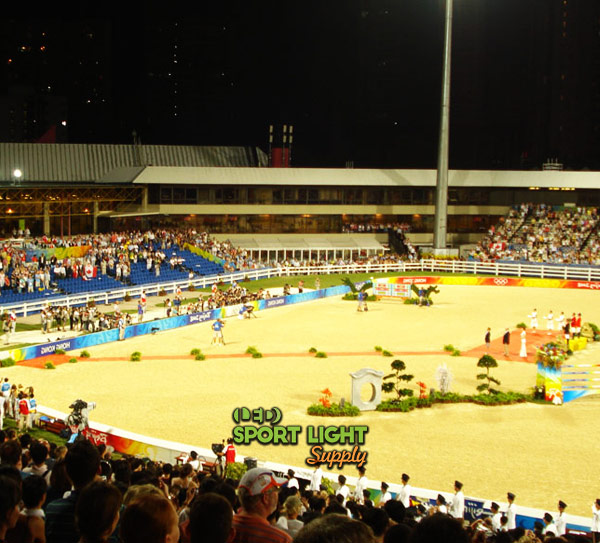 Lumens equal Lux when it’s multiplied by the square meter. For every 100 square meters, the amount of Lumens for the riding arena uses a formula. This starts with 200 Lux multiplied by 100 square meters and then multiplied further by 1.2 to accommodate for light loss. The answer becomes 24,000 Lumens needed. The light loss must be added due to the height of high mast poles and their distance from the arena.
Lumens equal Lux when it’s multiplied by the square meter. For every 100 square meters, the amount of Lumens for the riding arena uses a formula. This starts with 200 Lux multiplied by 100 square meters and then multiplied further by 1.2 to accommodate for light loss. The answer becomes 24,000 Lumens needed. The light loss must be added due to the height of high mast poles and their distance from the arena.
Though the amount of light loss may be slight, this adjustment is required anytime you have larger horse arenas outdoors. This isn’t so much of a problem for indoor arenas since lights are hung facing downward. But based on the total size of the arena itself, this formula must be calculated nonetheless. Higher ceilings for indoor events will require the angle beam to be adjusted so the Lumens being spread, is evenly distributed over the floor.
Where the light is angled for outdoor arenas, the Lux level should be evenly distributed so there aren’t hot spots created. This can be caused by overlapping corner lights incorrectly or from sidelights that have higher Lumen output.
How many watts to light a riding horse arena?
To estimate the Wattage that’s required, it directly relates to the Lumens you have determined. In this case, if you need 150 Lumens per Watt, here’s how to estimate that. To illuminate 100 square meters, you will need 24,000 Lumens. So this means that 24,000 then is divided by 150 Lumens which equals 160 Watts. This is the answer to how to estimate the number of watts an LED fixture will produce.
Once the Wattage is determined the exact power of a LED light fixture can be decided upon. This will give you the appropriate amount of Lumens for indoor or outdoor venues. These lights can also include dimming control which can lower the light level to various degrees. You won’t have to compromise the light intensity if you only need practice lighting. Instead, the light level can be brought down to levels that are more comfortable for horse trainers.
This can also apply to conditions that are outdoors and adjust to the changes in light as the sun goes down. These lights can be increased as daylight ceased to deliver enough arena lighting. Some systems can be controlled using a simple smartphone app to change the light level immediately.
What determines the Lux required for lighting a horse arena
1. Level of competition
As you already know, practice lighting will not be as high as competition lighting. The two types of competition fall into the intermediate and upper-level categories. Intermediate can be regional and local exhibitions whereas the national and international events are all reserved for the upper levels. When you see how bright the upper-level horse arenas are compared to intermediate, it’s mostly to improve the lighting conditions.
The media will also play a large role in needing enough light to photograph and film the horses’ performance. If there are TV cameras that use slow motion, the extra light helps keep these images nice and clear. It’s also for the improved lighting that judges need to study the purity and agility of trained horses.
2. Horse arena owners’ preference
It won’t be much of a surprise that some equestrian owners prefer brighter while others like dimmer light. This is strictly meant for training purposes and doesn’t have to be a set Lux level. It just comes down to what kind of budget you have for adding lights to a practice arena. Having lighting control with a dimmer makes this an easy task, so trainers can also adjust lighting conditions.
This can also be an advantage to simulate the higher level of lighting for professional competitions. It can also help condition a horse so their eyes aren’t too sensitive to lights that are set at lower levels. Using this light conditioning, horses will be calm when stronger lights are used.
What determines the Lumens and Watts of riding arena lighting fixture?
1. Light source
If you are using metal halide, mercury vapor, or halogen lights, you will need higher wattage because these types of light have lower luminous efficiency. This also makes it harder to control the cost of horse arena lights since the wattage will be so high. Not only is the overall cost expensive enough, but these types of lights also have a specific schedule that you have to work around.
These lights cannot be turned on instantly and take time to warm-up. It takes an average of 20 minutes to reach the peak light level. This makes any kind of practice or semi-professional arena more problematic. Another problem is that these lights can’t be immediately restarted, as they need to cool off before turning them on. This creates more problems as the cooling down process takes 30 minutes to cool and another 20 to regain max light levels.
2. Ceiling height or pole height
Higher installation heights ultimately mean more light loss, so in turn, this means that more Lumens are needed to compensate for this slight loss. Higher light poles also need to have a bit more lumen power added so that light loss doesn’t affect the horse arena. Even though the recommended amount of light is estimated beforehand, light loss accounts for the distance and height and may appear dimmed as a result.
The large outdoor arena that is meant to hold professional equine horse events need to be taller when more spectators are viewing the show. This in turn will need light levels appropriate for the type of event that is happening. Professional light levels need to have light loss compensation just as much as semi-professional events would. It’s always better to have a calculation done beforehand to ensure the best lighting possible.
3. Beam angle of horse arena lights
If you are using larger beam angles on floodlights that include 90 degrees, higher wattage is also required since the light beam becomes diverged. This can apply to both indoor and outdoor lighting needs. When there are very high ceilings, we need to have higher beam angles to allow the lights to blend-in with neighboring light fixtures. Stray light that isn’t going where it should be a sign that a light fixture has a poorly designed reflector.
For narrow beam angles that are meant for high ceilings always need higher angles to allow light to distribute itself. You don’t want to use floodlights that have wide angles on tall light poles since this will have a light that is bleeding outside the area you want to illuminate. This further adds to the glare problems and light pollution.
A light analysis is recommended to estimate the best possible outcome so a horse arena has the correct Lux and Lumen levels.
Our conclusion
Determining the correct light levels for your horse arena is not exactly rocket science. We aim to make your lighting task a lot easier to estimate using these special formulas for getting the right Lux and Lumens. This also gives you an insight as to why LED lighting is better for your venue. Not only is it cost-effective and long-lasting for decades, the overall costs compared to other light fixtures is easy to see.
The amount of wattage that’s reduced using LED light is an immediate cost reduction as well. If you have any questions about how lighting can best be achieved for your arena, we do offer a free DIALux lighting analysis. This gives you an incredible look at a 3D simulation that shows you how your horse arena can be improved. No matter if you need lighting indoors or outdoors, we have lighting solutions perfect for you.

